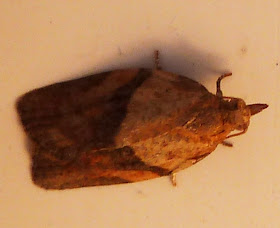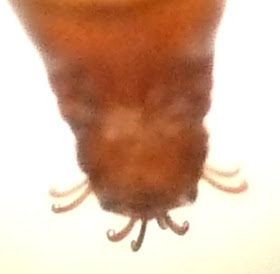If you are a regular reader of 'the spot', you'll know that I keep stick insects, and will have seen
images of them on their favourite British food, brambles (
Rubus fruticosus). Bramble is an excellent plant from an insect-owner's perspective because it is freely available just about anywhere with woodland, hedgerows, rough ground, gardens and so on. It is however a wild plant and therefore occasionally includes other unexpected invertebrates. So, when I found a couple of pupae (AKA chrysalis) while cleaning out one of the cages, I wasn't particularly surprised, but I was intrigued to know what they were. As my stick insects are breeding, I have a container full of eggs and this is where the pupae were put. Shortly afterwards, this is what I found...
 |
| Pupal cases after adults have emerged |
The pupal case on the left is in dorsal view and shows where the wings developed, plus the split where the adult emerged. You can also see the abdominal segments with rings of small protrusions, plus hooks for attachment at the tip (see below for more detail). The case on the right is in oblique/ventral view and shows where the antennae (note the annulations) and legs developed, as well as again showing the split through which the adult emerged. As these were in a sealed container, albeit with air-holes, it was never going to be tricky to find the adults, and I managed to photograph both of them - micromoths of the family Tortricidae.
 |
| One of the emerged adult tortricid moths. Note the darker rear half of the wings with paler curved bars to the sides. Length approx 16mm. |
 |
| The second tortricid moth, noting the very different wing pattern. Length approx 20mm. |
The overall form shows they are in the family Tortricidae, but there was of course no guarantee that they were the same species, especially given how different they look. However, there was clear evidence they were in fact the same species, and indeed different sexes...
 |
| Tortricid egg mass |
This egg mass, along with several others, was found inside the lid and with no other insects present had to be the product of these moths. The eggs had been laid in moulded fold in the lid just as, when outdoors, they would be laid in shallow folds of the upper surface of leaves and the greenish colour would offer camouflage. A closer look showed the next stage.
 |
| Tortricid moth larva |
I soon noticed a few tiny, recently hatched larvae, no more than 2-3mm long. The head is to the right (you can see the feeding apparatus as a short dark line) and the segmentation is just visible. By now I had identified the adults as
Epiphyas postvittana, the Light Brown Apple Moth; a species with highly variable markings as you can see - more examples are given in Manley (2008). It is a native of Australia, first recorded in Britain in 1936 (possibly as early as 1911), which is now abundant in the south of the country and spreading northwards, aided by its polyphagous diet (i.e. it eats leaves of many plants). This species is also known for its sexual dimorphism - males (the top photo) are smaller with a sharp change in colour across the wings; the larger females are more uniformly coloured as seen in the lower photo (Bradley
et al. 1973). In Australia it is a pest of apple orchards (and may well have arrived with imported fruit), but in Britain it feeds on other plants, only eating apple foliage in captivity. So, the title may be a little unfair to this species - its larvae 'devour' no more than any other species, though it is non-native and arguably invasive if it competes with native species for food.
So, an unexpected indoor arrival, but a good opportunity to look at a range of stages of its life cycle - I'll leave you with a few more images of the pupal cases.
 |
| The tip of the abdomen of a pupal case of E. postvittana - the hooks (note the curled 'Velcro'-like tips) are used to attach to plants during pupation. |
 |
| Ventral view of an E. postvittana pupa. The antennae are the clearest elongate structures, while the positions of the legs and mouthparts are also visible. |
 |
| An example of how much detail can be seen - as well as the fine sculpturing of the surface of the pupa, and the sutures between segments, a spiracle can be seen bottom right. |
References
Bradley, J.D., Tremewan, W.G. & Smith, A. (1973).
British Tortricoid Moths. Cochylidae and Tortricidae: Tortricinae. Ray Society, London.
Manley, C. (2008).
British Moths and Butterflies: A Photographic Guide. A&C Black, London.








No comments:
Post a Comment